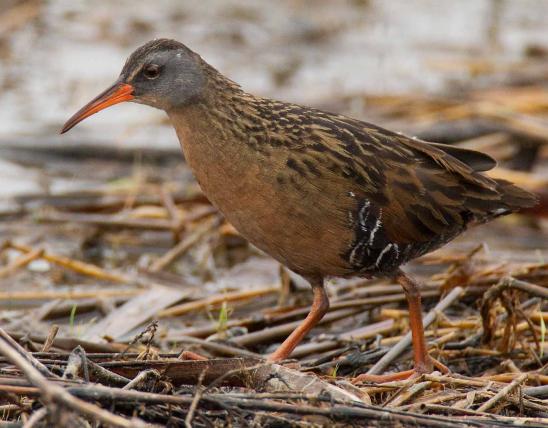
The pigeon-sized least bittern is usually seen in flight over a cattail marsh. Adult males have buff and chestnut inner wing patches that contrast sharply with the black of the outer half of the wings. Females and immatures are brown instead of black. Song is a rapid, soft series of notes, coo-coo-coo-COO-COO-Coo-coo-coo, usually sung in the predawn and dusk. It is similar to the song of the black-billed cuckoo, and it might be mistaken for the chuckling sounds made by some frogs. Calls are varied, including a startled qua, and a series of keks that sound like those of rails.
Similar species: The American bittern is more than twice as large. The green heron is also much larger. Rails are also found in marshy areas, but their necks are short and they lack the sharp-contrasting wing patches described above.
In flight, least bitterns have buff and chestnut patches on their inner wings and dark on the outer half of the wings. To separate them from green herons, note that least bitterns are about two-thirds the size of green herons, and green herons lack the light wing patches.
Length: 13 inches (tip of bill to tip of tail); about the size of a pigeon.

Statewide.
Habitat and Conservation
In summer, least bitterns frequent cattail and river bulrush marshes, shrub swamps, and sometimes cattail-choked farm ponds. Listen at dawn and dusk for their soft calls. Least bitterns straddle plant stems just over the water, and they freeze instantly, bill pointed up, if alarmed. Seeing them requires patience, unless you canoe or wade through the wetlands where you heard them. Try waiting quietly, scanning above the cattails of a marsh; you may see one fly low and disappear into the vegetation again.
Food
Like other herons, the least bittern forages around shallow water, stalking prey slowly, then quickly jabbing with its bill. Being a small heron, this species eats relatively small fish, plus insects and other small animals it can capture and swallow.
Status
Uncommon, local summer resident. A Missouri species of conservation concern.
Life Cycle
Platform nests are frequently constructed 1–4 feet above water in cattails, river bulrushes, nutsedges, and buttonbushes in deepwater sites. A roof of bent-over stems is often constructed over the nest. A clutch comprises 2–7 eggs. Upon hatching, the down-covered young are fairly helpless. Least bitterns arrive in Missouri in May and fly south by the beginning of October. Their year-round and winter range extends from southern Florida and Mexico clear down to southern Brazil.
Human Connections
These secretive birds are difficult to study, and researchers do not have much information about population trends. It is likely that loss of wetlands has affected, and is affecting, this species, causing declines. For the sake of this and many other species, we must preserve wetland habitats!
Ecosystem Connections
The behavior of camouflaged animals goes far to making their cryptic coloration successful. When a least bittern freezes with outstretched neck and up-pointed bill, swaying gently with the breeze, it blends perfectly with the surrounding grasses. Many camouflaged insects have similar behaviors.
























About 350 species of birds are likely to be seen in Missouri, though nearly 400 have been recorded within our borders. Most people know a bird when they see one — it has feathers, wings, and a bill. Birds are warm-blooded, and most species can fly. Many migrate hundreds or thousands of miles. Birds lay hard-shelled eggs (often in a nest), and the parents care for the young. Many communicate with songs and calls.





























